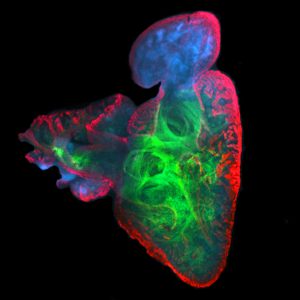
Masud, SN; Srivastava, A; Mero, P; Saba Echezarreta, V; et al. (2025) Genetic suppression features ABHD18 as a Barth syndrome therapeutic target. Nature, doi: 10.1038/s41586-025-09373-5.
Erkut, E, Somerville, C, et al. (2025) A novel cardiovascular, craniofacial, and neurodevelopmental disorder caused by pathogenic variants in the eIF3 complex component genes EIF3A and EIF3B. American Journal of Human Genetics, doi: 10.1016/j.ajhg.2025.09.008. (co-corresponding author)
Song, M., Yuan, X., Racioppi, C., Leslie, M., Aleksandrova, A., Christiaen, L., Wilson, M.D. and Scott, I.C. (2022) GATA4/5/6 family transcription factors are conserved determinants of cardiac versus pharyngeal mesoderm fate. Science Advances 8 (10) doi: 10.1126/sciadv.abg0834.
Rosenthal, S.M., Misra, T., Abdouni, H., Branon, T.C., Ting, A.Y., Scott, I.C. and Gingras, A.C.G. (2021) A toolbox for efficient proximity-dependent biotinylation in early zebrafish embryos. Molecular and Cellular Proteomics doi: 10.1016/j.mcpro.2021.100128.
Stutt, N., Song, M., Wilson, M.D. and Scott, I.C. (2021) Cardiac specification during gastrulation – The Yellow Brick Road leading to Tinman. Seminars in Cell and Developmental Biology, doi: 10.1016/j.semcdb.2021.11.011.
Yuan, X., Scott, I.C. and Wilson, M.D. (2021) Heart enhancers: development and disease control at a distance. Frontiers in Genetics 12, doi: 10.3389/fgene.2021.642975.
van Eif, V., Protze, S., Bosada-Musselwhite, F., Yuan, X., Sinha, T., van Duijvenboden, K., Ernault, A., Mohan, R.A., Wakker, V., de Gier-de Vries, C., Hooijkaas, I., Wilson, M.D., Bakkers, J., Boukens, B.J., Black. B., Scott, I.C. and Christoffels, V. (2020) Genome-Wide Analysis Identifies an Essential Human TBX3 Pacemaker Enhancer. Circulation Research 127(12):1522-1535.
Liang, M., Soomro, A., Tasneem, S., Abatti, L., Alizada, A., Yuan, X., Uusküla-Reimand, L., Antounians, L., Paterson, A., Rivard, G.-E., Scott, I.C., Mitchell, J., Hayward, C. and Wilson, M.D. (2020) Enhancer-gene rewiring in the pathogenesis of Quebec Platelet Disorder. Blood 136 (23), 2679-90.
Lee, S.-H., Hadipour-Lakmehsari, S., Murthy, H.R., Gibb, N., Miyake, T., Teng, A.C.T., Cosme, J., Yu, J.C., Moon, M., Lim, S.H., Wong, V., Liu, P., Billia, F., Fernandez-Gonzalez, R., Stagljar, I., Sharma, P., Kislinger, T., Scott, I.C. and Gramolini, A.O. (2020) REEP5 depletion causes sarco-endoplasmic reticulum vacuolization and cardiac functional defects. Nature Communications 11 (1), 965.
Gibb, N., Lazic, S., Yuan, X., Deshwar, A.S., Leslie, M., Wilson, M.D. and Scott, I.C. (2018) Hey2 regulates the size of the cardiac progenitor pool during development. Development 145 (22), dev167510.
Finding that hey2 restricts the contribution of Second Heart Field (SHF) cells to the developing heart, and therefore is a regulator of cardiac chamber size and cardiac proliferation.
Yuan, X., Song, M., Devine, P., Bruneau, B.G., Scott, I.C.* and Wilson M.D.* (2018) Heart enhancers with deeply conserved regulatory activity are established early in zebrafish development. Nature Communications 9 (1), 4977. (* co-corresponding author)
Chosen by Faculty of 1,000; featured as an Editor’s Highlight by Nature Communications.
Identification of conserved enhancers (aCNEs – accessible conserved non-coding elements) that are active during early development and are conserved between zebrafish and human. This toolbox of 6,000+ enhancers is being exploited to identify key non-coding regulators of development, regeneration, and human disease.
Deshwar, A.R., Onderisin, J.C., Aleksandrova, A., Yuan, X., Burrows, J.T. and Scott, I.C. (2016) Mespaa can potently induce cardiac fates in zebrafish. Developmental Biology 418 (1), 17-27.
Deshwar, A.R., Chng, S.C., Ho, L., Reversade, B. and Scott, I.C. (2016) The Apelin receptor enhances Nodal/TGFβ signaling to ensure proper cardiac development. eLife 10:e13758.
Lou, X., Burrows, J. and Scott, I.C. (2015) Med14 cooperates with brg1 in the differentiation of skeletogenic neural crest. BMC Developmental Biology 15(1):41.
Burrows, J.T.A., Pearson, B.J. and Scott, I.C. (2015) An in vivo requirement for the Mediator subunit Med14 in the maintenance of stem cell populations. Stem Cell Reports S2213-6711.
Yoruk, B., Giller, B.S., Chi, N.C. and Scott, I.C. (2012) Ccm3 functions in a manner distinct from Ccm1 and Ccm2 in a zebrafish model of CCM vascular disease. Developmental Biology 362 (2), 121-131.
Analysis of ccm3 loss-of-function in zebrafish, and demonstration that CCM3 may function is a pathway distinct from CCM1/2.
Paskaradevan, S. and Scott, I.C. (2012) The Aplnr GPCR signals independently of Gαi/o proteins and cell-non-autonomously in the development of myocardial progenitor cells. Biology OPEN 1 (3), 275-85.
Lou, X., Deshwar, A.R., Crump, J.G. and Scott, I.C. (2011) Smarcd3b and Gata5 promote a cardiac progenitor fate in the zebrafish embryo. Development 138 (15), 3113-23.
Demonstration that activity of Gata5 alone can drive cells to migrate and contribute to heart development. This again suggests that key events in cardiogenesis happen very early in development, well before the expression of canonical cardiac mesoderm markers.
Lazic, S. and Scott, I.C. (2011) Mef2cb regulates late myocardial cell addition from a second heart field-like population of progenitors in zebrafish. Developmental Biology 354 (1), 123-133.
Demonstration that the zebrafish heart, as is true for the mammalian heart, is built via two waves of cell addition.
Takeuchi, J.K.*, Lou, X.*, Alexander, J.M., Sugizaki, H., Delgado-Olguin, P., Holloway, A.K., Mori, A.D., Wylie, J.N., Munson, C., Zhu, Y., Zhou, Y.-Q., Yeh, R.-F., Henkelman, R.M., Harvey, R.P., Metzger, D., Chambon, P., Stainier, D.Y., Pollard, K.S., Scott, I.C. and Bruneau, B.G. (2011) Chromatin remodelling complex dosage modulates transcription factor function in heart development. Nature Communications 2, 187.
Scott, I.C., Masri, B., D’Amico, L.A., Jin, S.-W., Jungblut, B., Wehman, A.M., Baier, H., Audigier, Y. and Stainier, D.Y.R. (2007) The G protein-coupled receptor Agtrl1b regulates early development of myocardial progenitors. Developmental Cell 12 (3), 403-413.
First description of the role of Aplnr signaling in cardiac development, and suggestion that early events during gastrulation may primes cells for cardiac contribution.

